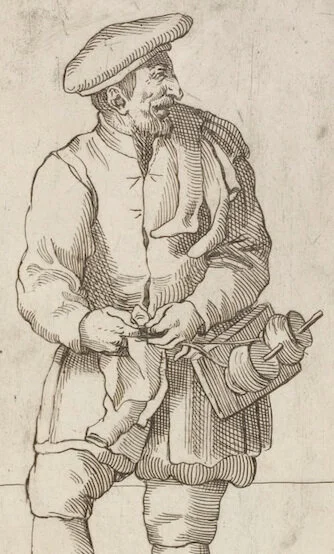MUST-HAVE TOOLS FOR TRAVELING KNITTERS
There's nothing better than sitting in a comfortable chair looking out at the beautiful scenery with a project in your lap. It’s especially lovely if you can knit while you’re out and about or in transit. For The Modern Maker, it is incredibly rewarding when we can knit in the same way our ancestors did in the years before.
While the concept of knitting while traveling is all well and good, sometimes the logistics of putting your project together for the road can be overwhelming. Here are some tips and tricks to make your crafting a little easier!
Historical Depictions of Knitting
A close up of Madonna Knitting, Bertram of Minden (1400-1410)
Paintings from the early 15th century show a few ways that knitting was stored for use. In Madonna Knitting, by Bertram of Minden (1400-1410), we can see The Madonna knitting a sweater with double pointed needles from a yarn that is stored in a stiff basket while she knits outside.
A close-up of A painting of the Holy Family attributed to Ambrogio Lorenzetti of Siena, c 1345
Another depiction of The Madonna also shows her knitting from a wooden plate filled with quills while sitting inside with the family. It is a hotly debated topic what The Madonna is knitting and what her knitting materials are made of in these images. We don’t know what she’s knitting either, but we wanted to make note of them in our research.
For those that want to go the extra mile, you can always have a yarn holder like the one depicted in one of the Le Arti di Bologna etchings in the Victoria & Albert Museum archive. Because of the way the stocking in his hands appears, he may even be using the Eastern technique of knitting two stockings at once on one set of needles (details on this will be saved for a future blog post)!
By the 17th century, we start to see the use of bentwood boxes for storage of tools and other objects.
A close up of Calzettaro, an etching from the Le Arti di Bologna collection, attributed to Annibale Carracci
Whether you're knitting in a historical way or in a modern way, here are some suggestions for tools to have on hand while traveling.
For the Historically Inclined Knitter
A STURDY CONTAINER
If you’re going to be traveling with your projects, you will need a container that’s up to the task. If you’re creating a historically inclined kit for knitting, stiffened baskets or bentwood boxes are good options.
SMALL SCISSORS
When you’re working with any form of fiber, having a small pair of scissors will save you from a huge headache down the road.
YARN NEEDLES
Yarn Needles (or tapestry needles) are a go-to for finishing off a project or if you need to join two yarns together.
SCRAP YARN
Scrap yarn has a variety of uses, like holding your stitches or acting as stitch markers.
A PHYSICAL COPY OF YOUR PATTERN
Nothing is worse than forgetting where you are in the middle of a pattern. Keeping a physical copy of your pattern will make sure you keep the flow going.
A WRITING UTENSIL
Should you need to edit your pattern, a pencil or another writing utensil will be very helpful to you. While they are not a part of history, making notations with a highlighter will make it easier to read the pattern and help you remember your knitting size.
EXTRA KNITTING NEEDLES
If you’re working on a project that needs one pair of needles or more, make sure to bring a few spares with you in case you lose a needle or find yourself having to commit to a 3-needle bind off.
For the Modern Knitter
TOTE BAGS/TRAVEL CONTAINERS
For modern knitters a shaped tote bag or a box is a good idea, and even better if they have plenty of pockets for organizing!
STITCH MARKERS
If you’re working on large or complicated projects, stitch markers are the best way to keep track of your progress.
POINT PROTECTORS FOR NEEDLE TIPS
Point protectors are a must have if you’re traveling in the 21st century. You’ll not only protect your work from slipping off the needle, you’ll protect your bag from damage.
STITCH HOLDERS
Stitch Holders can be key if you’re knitting sweaters or other garments while on the road. Be sure to pack a few before you start traveling! Make sure they’re the right size for the project.
A DIGITAL COPY OF YOUR PATTERN
If you have an electronic device capable of storing data, it never hurts to keep a digital copy of your pattern on hand, especially if your physical copy gets damaged while in transit.
Prep Your Pack
Before leaving the house, check and double check your pack to make sure you have everything you need. Make sure to dedicate a holding container just for your knitting, you don’t want to have ink or water spill all over your beautiful yarn! Your box or bag should be sturdy enough to hold up to wear and tear from traveling.
Flying While Knitting
If you plan to fly domestically or internationally, it is critical that you read up on approved and banned objects from your selected airline. The website for the Transportation Security Administration of the United States declares knitting needles safe for travel, as long as they are encased and protected. Sadly some agents still consider knitting needles dangerous and may confiscate them anyway, so if you are flying don’t take your best needles.
Sewing needles and scissors are also approved by the TSA (as long as the blades are less than 4 inches and encased for protection) but our warnings about TSA agents confiscating knitting needles also applies to sewing needles and scissors.
If you fly internationally, The European Union has rules that conflict with the TSA regarding sharp objects. On their Information for air travelers website there is a list of prohibited items for your hand luggage and it states that “scissors with blades of more than 6 cm as measured from the fulcrum” are prohibited in EU airports. So if you plan to craft while flying make sure to keep the really nice tools at home.
Knitting on the Road
If you’re going to spend many hours on the road, there is no better way to keep your hands busy than with knitting. Keep in mind that you’re will be sitting in a moving vehicle for a long while, so be sure to take plenty of breaks and stay hydrated. There’s nothing worse than your hands cramping halfway through the trip. Always bring your favorite hand lotion or balm for the trip.
Any trip can be easily ruined if you are not having fun. That is even more true if you don’t have all the tools you need to work on your projects. Take the time and energy to make sure your traveling tools are on point (pun intended) and you will always have a fun time while knitting on the go.
Do you have a favorite way of traveling with your knitting project? Share them with us in the comments, we’d love to hear them.
As always, happy stitching!




